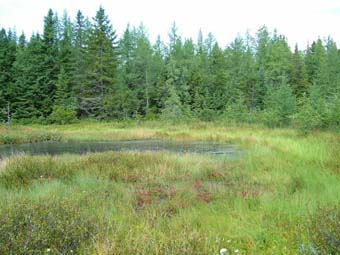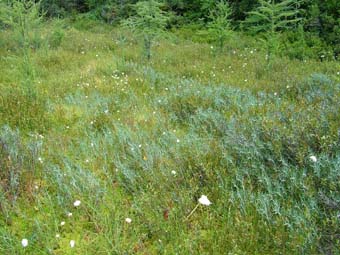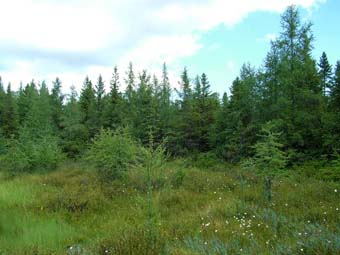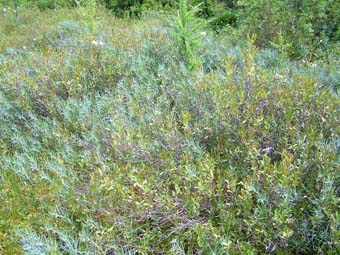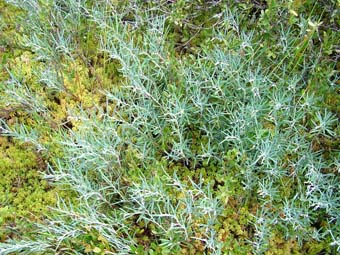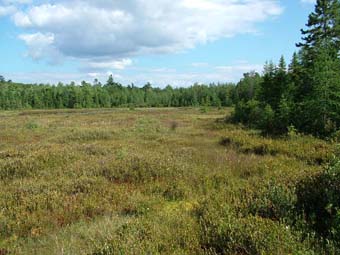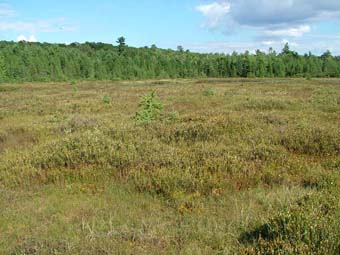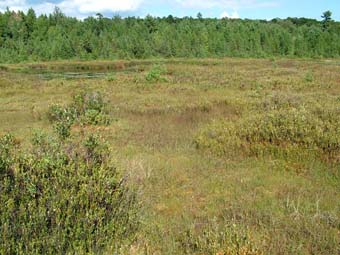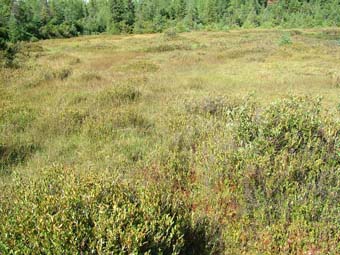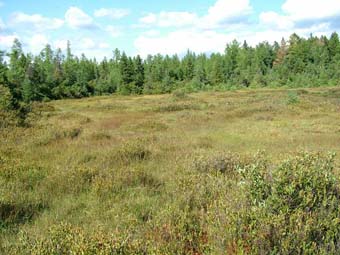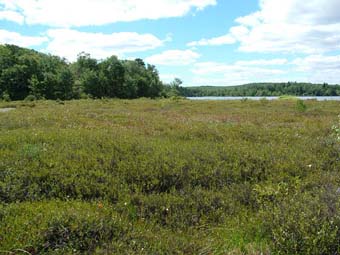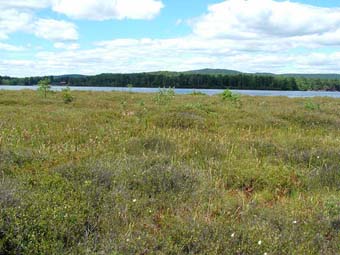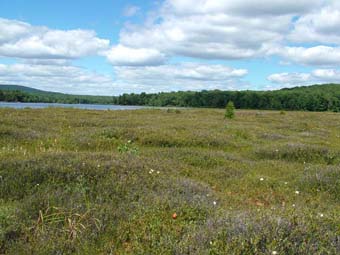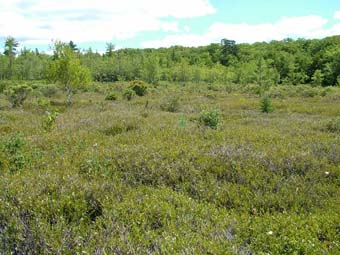Leatherleaf – Cranberry Bog
System: Palustrine
Subsystem: Shrubland
PA Ecological Group(s): Peatland Wetland
Global Rank:G5
![]() rank interpretation
rank interpretation
State Rank: S2S3

General Description
This dwarf shrub-dominated community (less than 0.5 m in height) is often part of the classic floating/quaking bog-mat community matrix found in glaciated areas of northern Pennsylvania. In glacial bogs, this community often occupies the central zone or one of the final zones of rooted vegetation surrounding an open water interior (also see water-willow (Decodon verticillatus) wetland type). This community type usually occurs in oligotrophic, peat-accumulating basins as part of the acidic glacial peatland complex. Substrate is organic and may be flooded at times but remains saturated throughout the growing season. The peatland where this community usually occurs may be oligotrophic or influenced by groundwater.
The dominant species are leatherleaf (Chamaedaphne calyculata var. angustifolia) – stunted form, cranberry (Vaccinium oxycoccos and macrocarpon), and sphagnum. Associates include pitcher-plant (Sarracenia purpurea), round-leaved sundew (Drosera rotundifolia), white beak-rush (Rhynchospora alba), yellow-eyed-grass (Xyris torta spp.), and tawny cotton-grass (Eriophorum virginicum).
Rank Justification
Vulnerable in the jurisdiction due to a restricted range, relatively few populations, recent and widespread declines, or other factors making it vulnerable to extirpation.
Identification
- Occurs in oligotrophic, peat-accumulating basins in the glaciated areas of northern Pennsylvania
- May be a community within the acidic glacial peatland complex
- In glacial bogs, this may be the central community or final zone of rooted vegetation before open water
- Substrate is organic and remains saturated throughout the growing season
- The shrub layer is less than 0.5 m in height and dominated exclusively by dwarf leatherleaf
- A continuous sphagnum layer is present that may feel like it is “floating” when walked upon
- In addition to dwarfed leatherleaf, characteristic herbaceous bog species are present such as cranberry, pitcher-plant, round-leaved sundew, and cotton-grass
Herbs
Bryophytes
* limited to sites with higher soil calcium
Vascular plant nomenclature follows Rhoads and Block (2007). Bryophyte nomenclature follows Crum and Anderson (1981).
International Vegetation Classification Associations:
USNVC Crosswalk:None
Representative Community Types:
Southern New England Bog (CEGL006008)
NatureServe Ecological Systems:
North-Central Interior and Appalachian Acidic Peatland (CES202.606)
NatureServe Group Level:
None
Origin of Concept
Fike, J. 1999. Terrestrial and palustrine plant communities of Pennsylvania. Pennsylvania Natural Diversity Inventory. Pennsylvania Department of Conservation and Recreation, Bureau of Forestry, Harrisburg, PA. 86 pp.
Pennsylvania Community Code*
SR : Leatherleaf – Cranberry Peatland
*(DCNR 1999, Stone 2006)
Similar Ecological Communities
Leatherleaf – Cranberry Bog is most similar to Leatherleaf – Bog-rosemary Bog in terms of plant species. Vegetation assemblage may be similar, but the overwhelming dominance of stunted leatherleaf (Chamaedaphne calyculata var. angustifolia) distinguishes Leatherleaf – Cranberry Bog from the taller, more diverse Leatherleaf – Bog-rosemary Bog.
Fike Crosswalk
Leatherleaf - cranberry peatland
Conservation Value
Rare plant species that may be found in this community include dragon’s mouth (Arethusa bulbosa), lesser panicled sedge (Carex diandra), many-fruited sedge (Carex lasiocarpa), few-seeded sedge (Carex oligosperma), few-flowered sedge (Carex pauciflora), bog sedge (Carex paupercula), bog muhly (Muhlenbergia uniflora), Labrador-tea (Rhododendron groenlandicum), bog goldenrod (Solidago uliginosa) and hooded ladies’-tresses (Spiranthes romanzoffiana). This community also serves as a buffer for sediment and pollution runoff from adjacent developed lands by slowing the flow of surficial water causing sediment to settle within this wetland.
Threats
Leatherleaf – Cranberry Bogs are threatened by habitat alteration (e.g. logging in adjacent uplands, flooding), deposition (e.g., sedimentation, nutrient loading), and alterations to the hydrological regime (e.g., removal of beaver dams or other impoundments, lowering of the water table). This community type may be more susceptible to degradation due to the fact that it is often associated with small, isolated basins. Plant collection pressure may add to the degradation of this community type.
Management
Because Leatherleaf – Cranberry Bogs are very acidic and low in nutrients, they are susceptible to alteration by elevated nutrient inputs. This wetland may require larger buffers than other wetland types because of their high susceptibility to changes in nutrient concentrations.
A natural buffer around the wetland should be maintained in order to minimize nutrient runoff, pollution, and sedimentation. The potential for soil erosion based on soil texture, condition of the adjacent vegetation (mature forests vs. clearcuts), and the topography of the surrounding area (i.e., degree of slope) should be considered when establishing buffers. The buffer size should be increased if soils are erodible, adjacent vegetation has been logged, and the topography is steep as such factors could contribute to increased sedimentation and nutrient pollution. Direct impacts and habitat alteration should be avoided (e.g., roads, trails, filling of wetlands) and low impact alternatives (e.g., elevated footpaths, boardwalks, bridges) should be utilized in situations where accessing the wetland cannot be avoided. Care should also be taken to control and prevent the spread of invasive species within the wetland. Alterations to groundwater sources should be minimized.
Research Needs
Research is needed to fill information gaps about this community type, especially to advance our understanding of their classification, ecological processes, hydrology, floristic variation, development, and succession.
Trends
Wetland protection has most likely stabilized the decline of this community, which was heavily impacted by peat mining activities. There may be cases of slight decline due to alteration of hydrology from impoundments (conversion to other palustrine community types).
Range Map
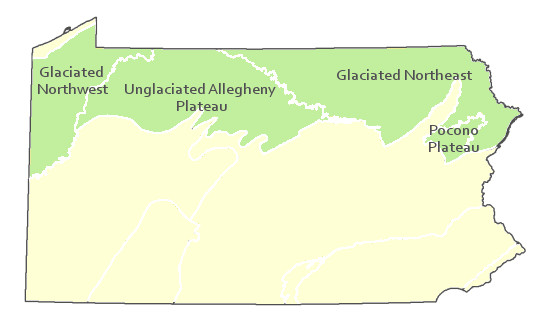
Pennsylvania Range
Glaciated Northeast, Glaciated Northwest, Pocono Plateau, and Unglaciated Allegheny Plateau.
Global Distribution
Connecticut, Massachusetts, Maine, New Hampshire, New York, New Jersey, Ohio, Pennsylvania, and Rhode Island. This community type also extends into Ontario.
Edinger, G.J., D.J. Evans, S. Gebauer, T.G. Howard, D.M. Hunt, and A. M. Olivero (editors). 2002. Ecological Communities of New York. Second Edition. A revised and expanded edition of Carol Reschke’s Ecological Communities of New York State. New York Natural Heritage Program, New York State department of Environmental Conservation. Albany, NY. 136pp.
Fike, J. 1999. Terrestrial and palustrine plant communities of Pennsylvania. Pennsylvania Natural Diversity Inventory. Harrisburg, PA 79 pp.
NatureServe. 2005. NatureServe Central Databases. Arlington, Virginia. USA.
Pennsylvania Department of Conservation and Natural Resources (DCNR). 1999. Inventory Manual of Procedure. For the Fourth State Forest Management Plan. Pennsylvania Bureau of Forestry, Division of Forest Advisory Service. Harrisburg, PA. 51 ppg.
Perles, S.J., G.S. Podniesinski, E. Eastman, L.A. Sneddon, and S.C. Gawler. 2007. Classification and mapping of vegetation and fire fuel models at Delaware Water Gap National Recreation Area: Volume 2 of 2 – Appendix G. Technical Report NPS/NER/NRTR – 2007/076. National Park Service. Philadelphia, PA.
Stone, B., D. Gustafson, and B. Jones. 2006 (revised). Manual of Procedure for State Game Land Cover Typing. Commonwealth of Pennsylvania Game Commission, Bureau of Wildlife Habitat Management, Forest Inventory and Analysis Section, Forestry Division. Harrisburg, PA. 79 ppg.
Cite as:
Furedi, M. 2022. Pennsylvania Natural Heritage Program. Leatherleaf – Cranberry Bog Factsheet. Available from: https://naturalheritage.state.pa.us/Community.aspx?=16041 Date Accessed: August 22, 2025


